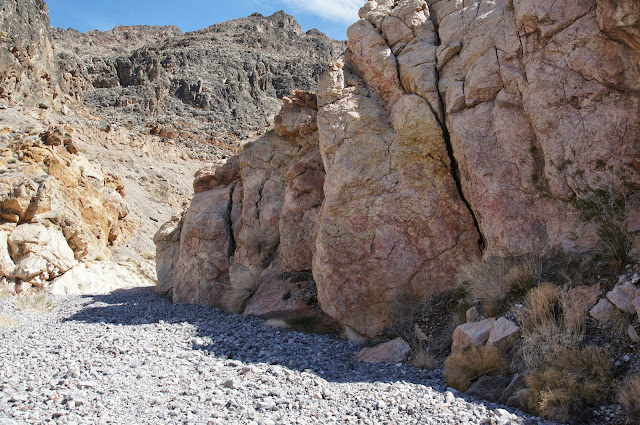Place: Death Valley National Park, California
Coordinates: 36.37250, -116.66552
Length: about 3 miles in and out
Difficulty: moderate
The morning after the storm my friend and I woke up to a crispy-clear morning. We had stayed the night in Death Valley Junction (south-east of the park) and the mountains all around were capped with fresh snow.
After a quick breakfast we headed westward on hwy 190, back to the park. It was just before entering the Amaragosa Mountain Range that we run into our first excitement of the day: a small group of wild horses, grazing lazily between the road and the mountains. Naturally, we stopped and observed them for some time.
 |
| Wild Horse |
 |
| The hike from hwy190 into Pyramid Canyon is labeled yellow |
 |
| The Trailhead of Pyramid Canyon |
 |
| Phacelia crenulata |
 |
| Camissonia brevipes (Yellow Cups) |
 |
| Mimulus bigelovii (Bigelow's Monkeyflower) |
 |
| Mohavea breviflora (Golden Desert Snapdragon) |

No real trail, and for 1 mile there's no canyon either, just a slow walk up the alluvial fan and appreciating the view ahead:
 |
| Pyramid Peak, wearing fresh snow |
 |
| The Amaragosa Range south of hwy 190 |
 |
| Echinocactus polycephalus (Cottontop Cactus) |
It is not called Coyote Melon for nothing, although several species eat the fruit of this plant. Apparently, it is very bitter and not edible to people. Native Americans used it to make gourds and soap.
 |
| Cucurbita palmata (Coyote Melon) |
 |
| Rock Wren |

As the canyon walls closed in on us, the rock formations appeared more and more interesting. I took many rock photos that day, but I only present this one here:
I wonder what is the geological story behind those layers.
At some point, the canyon opened up a bit and there, on the rocky ledges, we spotted a group of interesting shrubs. We observed them closely and took photographs. Non of them were blooming at the time. Later, my friend found out that this plant species is rare and endangered. A good encounter indeed!
 |
| Mortonia utahensis |

But not before I climbed this obstacle and looked at the next one, an even higher boulder block, upstream:
On both sides were sheer walls, and from various spots in the walls, water was seeping out. The exact point of spring water.
I climbed down and rejoined my friend and, after a short break we started back down the wash. We were all alone during that entire hike, not seeing any human, and hardly any other wildlife. It was very tranquil, and the weather was perfect. And we did get to see some desert flowers after all :-)
 |
| Mortonia utahensis |
Many thanks to my friend, עננת for identifying the plants. Thanks also to Papa Quail for identifying the rock wren.





it was a lovely hike, and the Mortonia has beautiful leaves and structure. too bad we didn't see it in bloom, thought :-)
ReplyDeleteWell, yes. As you've seen, it's hard to aim to the blooming time of anything there, where the season is so inconsistent. Maybe next time :-)
DeleteHooray for the flowers, the views, the weather and of course the hikers :-)
ReplyDeleteHooray for the Papas that allowed this hike, and that entire trip, to happen!
DeleteI'll second that :-)
Delete